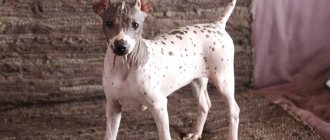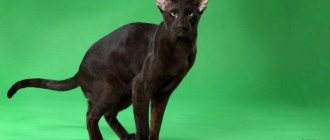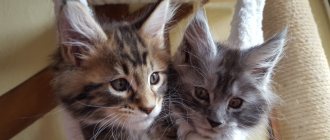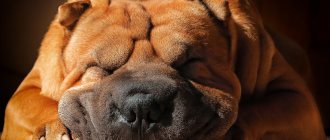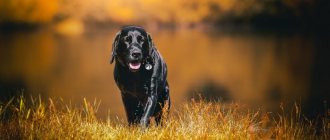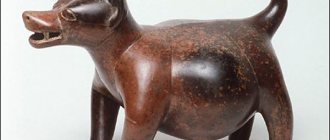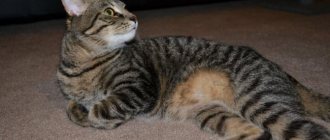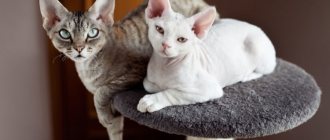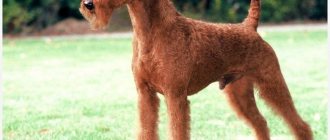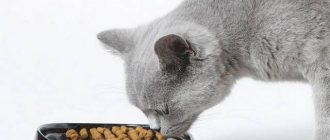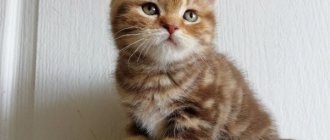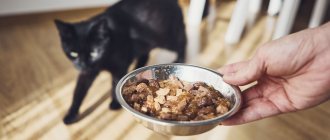Origin story
British cats are one of the oldest breeds. There are two legends about how the animals got to the island: according to one version, Roman legionnaires brought them to Foggy Albion; according to another, the cats sailed with French sailors, on whose ships they exterminated rodents. Be that as it may, the furry animals settled in England and became its full-fledged inhabitants. For a long time, they were ordinary street cats, selected only by Mother Nature. Due to the lack of an influx of new blood into the British population, genetic characteristics characteristic only of this breed have formed. The result was large animals with a massive body, charming round eyes and plush, densely stuffed fur that had water-repellent properties.
Due to living in a humid climate for a long time, the British have developed a dense, moisture-repellent fur coat.
Thanks to their intelligence, cleanliness and intelligence, British cats have gained the love and recognition of local residents. Then the work of specialists began on the formation of breed standards.
History of breeding
The British breed was first registered in 1898. Animals were very popular among English bohemians. But British cats of that time were mostly blue, which significantly reduced interest in the breed. At the beginning of the 20th century, people wanted something exotic, and they preferred Persians with a rich range of colors. Breeders, in order to restore the fading interest in the British breed, decided to diversify the color range of the British coat.
Animals of various colors began to be bred to increase interest in the breed
At first, selection work was carried out between new representatives of the breed, but the cats most often turned out were spotted forest colors or there were white spots, inclusions and medallions on the coat. Thus, it was not possible to escape from the basic genotype. Then felinologists began crossing British cats with Persians and individuals of other breeds similar in phenotype, due to which the color range of the British cats increased. In addition to the classic blue and smoky colors, the British have appeared in the most unusual color variations. In 1992, basic breed standards were established, which have remained virtually unchanged since then.
The modern British cat has more than 200 types of colors.
Black cats in culture and history
People's attitudes towards dark-colored cats have been different at all times and in different countries. In Great Britain, the black cat has always been a symbol of good luck and fortune. Also, according to English myths, a coal-colored cat drove away evil spirits and demons.
However, difficult times soon came (poverty, famine, plague), which led to a search for those responsible. And during the Inquisition, women who had coal-colored cats began to be considered witches. As a result, they, along with their owners, were put on fire after discovery.
Over time, dark-colored cats have once again become a symbol of good luck in many European countries and Egypt. Also, according to the legends of sailors, a cat with a black color is a symbol of luck and safety of the ship.
The British is an unusual breed and is not suitable for all people. A special feature is the animal’s devotion to its owner until the end of its life. They do not require much attention, but like everyone else they need love and care.
In addition, they have amazing abilities to help people with heart disease and hypertension. They are ideal for busy people who spend a lot of time at work and cannot constantly pay attention to their pet. This breed is distinguished by its calm nature and majestic behavior.
Pedigree features of the British cat
In order not to confuse a British cat with another breed, you should know its main distinguishing features.
Shiny raven-colored fur and sparkling amber eyes make the black Briton simply irresistible.
Table: external features of the breed
| Options | Description |
| Head | Round in front and in profile, with full cheeks, wide in the cheekbones, with a rounded structure of the underlying bone structures, sitting on a short thick neck. |
| Nose | Short, wide, straight. In profile, the transition from a rounded (convex) forehead to a straight nose is accompanied by a break (literally - break, which can also be translated as a depression, depression), which should be neither too shallow nor too pronounced. The color of the nose mirror directly depends on the color. |
| Chin | Strong, solid, well developed. The bite should be correct, and the lower point of the chin and the tip of the nose form a vertical line. |
| Muzzle | Well developed, with characteristically defined whisker pads. |
| Neck | Massive, short. There is a thick fold around the neck, characteristic only of this breed. |
| Ears | Small, with rounded ends. Set wide apart, emphasizing the round contours of the head. The outer surface of the ear is evenly covered with hair, the inner pubescence is moderately developed. |
| Eyes | Large, round, wide open. Placed straight. Eye color directly depends on color. Usually orange, color-point and white individuals have blue irises, chinchillas have blue to emerald irises. Some colors allow different eyes (heterochromia). Eye color should be bright and rich. |
| Body | Tightly built with a short, straight back. It appears squat due to short legs, with a wide and deep chest. Equally massive in the areas of the shoulders and croup. Medium size, not stretched. |
| Limbs | Round and strong, relatively short, with closed fingers. The forelimbs are straight and the same length as the hind limbs. |
| Paws | There are five toes on the front paws and four on the hind paws. The color of the pads directly depends on the color. |
| Tail | Thick, wide at the base, medium length, cone-shaped, with a rounded tip. |
| Wool |
The basic standards of a long-haired cat are fully consistent with the standards of a short-haired cat. |
| Weight |
|
| Lifespan | 10–15 years |
Korat
Korat is of Thai origin. These beauties are also called “symbols of good luck.” If such an animal appears in your home, expect prosperity and happiness. Also, thanks to its beautiful smoky silver color, many believe that the cat is capable of summoning wealth and a rich harvest.
The breed was only recognized in 1965. Cats are bred mainly in America, Canada, Australia, and Britain. But the Korats are especially popular and loved in their homeland, where they are considered sacred. Thais are against selling or exchanging cats.
Breed Features
The maximum weight of an animal is 5 kg, the minimum is 2 kg.
Table 4. Distinctive features of the Korat
| Cat body part | Breed Features |
| Torso | Strong, not massive, muscular. There is an inherent gracefulness. All body lines are smooth and graceful |
| Head | The area above the eyebrows is convex. Pointed chin. The head can be compared in shape to the heart |
| Ears | Large, wide. The ends are sharp |
| Eyes | Big ones. Highly placed. Widely spaced from each other. They perform a little. Color green, amber |
| Nose | Slightly convex. Lion's. Dark blue color |
| Limbs | The limbs are short. Paws are oval. The pads are dark blue in color |
| Tail | Thick, tapered at the end, medium length |
| Wool | Fits tightly to the body. Short, thin, with a sheen. No undercoat. Color only blue with a silver tint |
Character
These cats are very energetic, playful, and smart. They are very affectionate and gentle. They require great love from the owner. They do not want to share it with other pets. Therefore, it is quite difficult to get along with other four-legged household members. They respond well to training. They quickly get accustomed to the tray, scratching post and other convenient devices.
Cats play with children. They rarely show aggression. However, their hearing and sense of smell are heightened. They are afraid of sudden movements and sounds. Korats are true purrs; they love to chat with their owner, and with different tones. This allows the owner to quickly understand what his pet wants. Such pussies have a hard time being separated from their owners.
Health and care
Cats have good health, however, in veterinary practice, cases of atelosteogenesis (impaired proper bone formation) and gangliosidosis (retardation in physical development) have been reported.
Life expectancy under good conditions can reach 20 years. As for care, its methods are standard - combing (once a week), cutting nails, cleaning ears and eyes.
Genetics of color inheritance
There are so many colors of British cats that it’s easy to get confused among them. To organize the diversity of the color range, colors are divided into groups according to coat pattern, color and pigmentation. There are two basic colors that are directly involved in the formation of others:
- black;
- red.
Each color is formed due to a special substance - melanin. The pigment is found in a cat's hair in the form of microscopic granules that vary in shape, size and quantity. Melanin is divided into two chemical subtypes:
- zumelamine (gene B) - spherical granules that absorb light and form a black color (responsible for the black color and its derivatives);
- pheomelamin (gene A) - ellipsoidal granules that reflect light in the red range (producer of all shades of red).
The genes responsible for the offspring being red (O - orange) or black (o - not orange) are located on the X chromosome. The color of the future offspring is directly related to the gender of the parents. Females have two X chromosomes, and males have one, therefore, cats are responsible for three basic colors:
- OO - red;
- oo - black;
- Oo - tortoiseshell (red-black).
Genes located on the X chromosome are passed from mother to children. Accordingly, a red cat will not be able to give birth to black offspring, and a black cat will not produce red kittens. In cats, the color of the offspring depends on which gene is carried on the only chromosome (O or o), the choice is small - red or black. Tortoiseshell cats appear only in cases of pathology and are almost always infertile.
Cats can only be tricolor as a result of mutation.
If a cat has a tortoiseshell coloring, it means there is an extra X chromosome in his code. Characteristic gene mutations occur 1 time in 3 thousand individuals.
British black color
The dominant (dense) gene D and its companion, the recessive (diluted) gene d, are responsible for the color intensity. In order for the B gene (zumelamine) to appear and give a coal-black color, the cat must have the saturation gene D. Thus, for the formation of an intensely colored black color, dominant genes B and D must be present in the pet’s body. The recessive gene d dilutes the black color, makes it is washed out and gives lighter shades.
British black cats differ from their counterparts not only in color, but also in the quality of their coat - it is stiffer and has a characteristic, pronounced shine. This is due to the fact that the guard hair of black animals is more densely saturated with pigmentation. The signature plush coat is not typical for black individuals, but this is not considered a disadvantage.
Black British fur coats are denser and less plush.
The gene responsible for black color (zumelanin) is one of the ancient genes. Black color, along with tabby color, was often found in wild, undomesticated cats. This is why black and striped animals have a number of similar characteristics.
Character
Just because your pet doesn't run to the door to greet you doesn't mean he's not attached to you. It's just that the British understanding of love and friendship is somewhat different from the affection and loyalty of dogs. They seem to be on their own, but at the same time they desperately need your attention and care. The lop-eared dog will not impose itself, but if you notice that it has perched itself next to you, do not be lazy and pet it. He will be endlessly pleased.
These cats are completely non-aggressive , but they will stand up for themselves without hesitation. They are patient with children, but their patience has narrow limits. Therefore, you should not persistently squeeze or invade the animal’s personal space. You are not purchasing a toy for your child, but a living being with its own character, ambitions and desires.
The Briton gets along easily with other cats , although he will try to take a dominant position, and if he doesn’t succeed, he will simply act independently and aloof. With dogs, they can behave aggressively and hit the cheeks if they feel that they are being harassed or try to attack.
The furry nature of lop-eared animals is aimed at the instinctive desire to protect themselves. If the animal feels completely safe, feels love and at the same time the boundaries of what is permitted, then you will not be overjoyed to have this sweetest creature in your home. He will only delight and amuse you .
Black color standards
Black color belongs to the group of solid shades, which are also called solid. The name comes from the English solid - solid, solid. Solid colors are divided into seven main groups, each of which has its own code according to European standards.
Table: coding of the main solid colors of the British cat
| Color | Code |
| Blue | BRI a |
| Black | BRI n |
| Lilac | BRI c |
| Chocolate | BRI b |
| Cream | BRI e |
| White | BRI w |
| Red | BRI d |
Black representatives of the British breed are incredibly beautiful and attractive, but quite difficult to obtain the ideal color.
A black British cat's nose and paw pads should be the same color as their fur.
Expert requirements for black color:
- wool - evenly dyed to the very root, thick charcoal color; the undercoat should blend in with the main tone of the coat, shine is allowed;
- paw pads are black or charcoal in color;
- nose mirror - black;
- eyes: copper;
- orange;
- golden.
Black smoke cat - what breeds have this color?
Cats are adored for their amazing colors. The “black smoke” color of the cat’s coat is interesting for its unusual nature. The English name sounds like black smoke. Smoky shades are common among many breeds. According to the classification of colors accepted throughout the world, there are several types of smokes: black, tortoiseshell, cream, blue, chocolate, red, lilac.
The haze effect appears due to the pronounced contrast in the color of each hair. The tip is the most saturated shade, and the base is much paler or white.
How to choose a British dog with black coat
When buying a black British kitten, even from the most professional breeders, you cannot be sure that it will grow into a pet with high-quality black fur. The main problem is that small “emers” tend to fade. The pre-blooming stage lasts until the age of sexual maturity. During this period, kittens may have blurry patterns, brown undercoat, or so-called gray hair. Only at six to seven months can you be sure that the animal’s color has acquired a rich coal-black color.
Felinologists believe that smoky kittens during puberty have every chance of becoming the owner of luxurious raven-colored fur.
Don't panic if you find single, unpainted spots on your kitten's fur. Gradually, these hairs will fall out on their own, but sometimes they stay in the neck area for a long time and finally leave the animal’s coat after the first mating.
Only during puberty can you understand whether the British fur coat will be a rich charcoal color
In order not to make a mistake with the color and to be sure to become the owner of a black British cat, it is better to take an already grown-up kitten whose fur is sufficiently formed.
Black British eye color
All British cats are born with blue eyes, but at the age of three to four months they change color, acquiring their final color. Eye saturation is determined differently for everyone. Blue-eyed, black-colored Britons do not exist in nature, since the recessive blue tint cannot appear in combination with the dominant black coat.
The eyes of a black British cat at the age of three to four months lose their blue tint and acquire their final color
Breeders believe that the brighter the kittens' eyes, the less intense the color will be when they grow up. Conversely, an iris of gray shades suggests the most intense color, which is so valued in the British breed.
The most preferred eye color of a black Briton is a rich orange tint.
Smoky Brits: photo gallery
The gallery contains photos of British dogs of black smoke, chocolate smoke, blue smoke, cream smoke. Here you can see photos of British smoky kittens and adult cats.
| In our cattery you can “buy a real British kitten.” We have many different colors, we will help you choose and answer all your questions! |
| Please rate the article! (1 star - didn't like it, 5 stars - liked it) Thank you! |
Breeding British black kittens
Even for experienced breeders, it is very difficult to obtain high-quality black offspring, so it is best to carefully think through the breeding program in advance. Choosing the right parent pair is the main issue in breeding work. It is desirable that manufacturers meet certain requirements:
- both had a solid black color;
- in their pedigree there were as few ancestors with lightened colors as possible;
- Dominant and recessive color genes of British breeds were taken into account.
It is better not to breed black and blue cats with the same “rust” color. Cats with warm chocolate and lilac colors, as well as tabby colors in warm or “golden” tones, are undesirable for mating with black individuals, since these mating options are fraught with the appearance of reddish tones in black offspring.
I. Shustrova
https://do.gendocs.ru/docs/index-267867.html?page=5#6583271
Another necessary condition for the appearance of high-quality offspring is that both sires must be healthy at the time of mating, vaccinated on time and treated for parasites.
Perhaps one of these kittens will become the owner of a luxurious plain coat of jet black color
In order not to get the opposite result to the desired one, it is best to contact a felinologist. They will make a high-quality genetic calculation of the animal and select a suitable match for it. These tests are carried out taking into account the pedigrees of the potential parents.
Special compatibility tables for producers of different colors compiled in Russian nurseries will help you avoid getting a defective litter:
- when mating animals of a solid color with bicolors (tricolors), the offspring consists of 50% kittens of a solid color and 50% of bicolors (tricolors);
- when mating two bicolors (bicolor and tricolor), the litter will consist of: 50% bicolors (tricolors);
- 25% of kittens are solid color;
- 25% harlequin (5/6 part of the body is white).
Table: results of colors of black kittens from parents without agouti factor (uneven coloring of hairs)
| Cat | Cat | Kittens | |
| Boys | Girls | ||
| Black | Black |
|
|
| Black | Blue |
|
|
| Black | Redhead |
|
|
| Black | Cream |
|
|
| Black | Tortoiseshell |
|
|
| Black | Blue-cream |
|
|
| Blue | Black |
|
|
| Blue | Tortoiseshell |
|
|
| Ginger | Black |
|
|
| Ginger | Blue |
|
|
| Ginger | Tortoiseshell |
|
|
| Ginger | Blue-cream |
|
|
| Cream | Black |
|
|
| Cream | Tortoiseshell |
|
|
My blue British girl has a blue mother and a black father. The litter included one girl (my pet) and two black cats. When we arrived to pick up our cat, I saw her father for the first time. I couldn't even imagine how beautiful black British people are. These are graceful cats with incredible energy. It was simply impossible to take my eyes off my Tsili’s father. Shiny fur, bright eyes the color of freshly collected buckwheat honey. Mars (that’s the cat’s name) watched carefully as we put Tsilya in the carrier and accompanied us all the way to the door. He was probably assessing the new parents. Right at the exit, I risked petting the cat, and he didn’t resist. The hostess was even surprised, saying that Marsyusha was reluctant to make contact with strangers. The fur coat of a black cat is indeed tougher and denser than that of relatives of other colors. Our Tsili’s fur resembles a soft tsigeya, while Mars’s is like a natural carpet, but very well-groomed and pleasant to the touch. We also communicate with the owner of a cat from the same litter as our pet. Steve is a black, imposing cat, a real copy of his father, only with lemon-colored eyes. By nature, our brother Tsili is softer and more flexible. He calmly goes to communicate with everyone who enters the house and really loves tactile contact with the owners, which cannot be said about our too independent girl.
Price
Purebred kittens with documents and a decent pedigree cost about ten thousand rubles. There are many advertisements on the Internet in which they are willing to give you a kitten even for a thousand rubles, but no one can guarantee that you are buying a truly purebred animal. Just like no one will give you documents.
Therefore, we can say that the price depends on what exactly you want to purchase. If you only need a cat with the appearance of a Scottish Fold, then you can look through advertisements on the Internet. But if the breed and its purebredness are important to you, then it is best to go directly to the nursery.
Black British coat care
The coat of a black British cat will look perfect if you follow some rules:
- Black Britons, like everyone else, need proper nutrition. The diet should be balanced and varied. There are two feeding options: natural food or ready-made food (super premium line). Breeders do not recommend mixing dry food and natural products, as this can lead to gastrointestinal diseases in the animal. If a cat eats natural products, then its menu should include the following products:
- chilled lean meat or poultry breast;
- boiled sea fish;
- dairy products;
- vegetables and finely chopped greens;
- poultry eggs;
- kelp algae, which maintains the black color of the coat.
Algae maintains the black color of the British coat
- Since the coat of the black representative of the British breed is darker and coarser than that of its relatives, it gets dirty less and is easier to clean. Therefore, you should bathe your pet no more than once every six months. The Briton should be washed with special shampoos, preferably premium ones. Reasons for giving your pet an emergency bath:
- participation in exhibitions and competitions;
- severe contamination of the wool with something sticky, sticky or toxic;
- independent visit to the street;
The British are very clean animals, so they should not be bathed often.
- getting rid of tangles;
- removal of stuck impurities.
- The Black Briton needs to be brushed once a week with a slicker brush or a special fine-toothed comb. During molting, the animal needs to be scratched more often - about once every two to three days. A cat should be taught hygiene procedures from a very young age, otherwise the pet will be reluctant to accept them.
- For large British dogs, you should choose a spacious and comfortable tray and filler that does not stick to the animal’s fur.
- The Black British cat, like any domestic cat, needs annual vaccination and prevention of parasites.
British cats are prone to obesity, so you need to carefully ensure that they do not overeat. The slightest disruption in health can lead to a deterioration in the quality of the coat and loss of natural shine.
When we took our British cat from the breeders, they warned us that it was better to feed the animal natural products. The diet must include raw lean meat. The breeder advised us to immediately cut the purchased veal into long pieces and package it in portions. Before eating, the meat must be doused with boiling water. When chewing long bars, British children develop a correct bite and plump, as if stuffed cheeks, forming a unique “Cheshire smile.”
Australian mist
Mist was bred in Australia. Breeders living on the mainland wanted to create their own special breed. The breeding process lasted 11 years, from 1975. In the end, the local specialists managed to achieve their goal, and in 1986 a new unique breed was bred. In the same year it was officially registered.
Australian mist
Breed Features
The maximum weight of an Australian cat is 8 kg (for males), the minimum is 3-4 kg (for females). The animal's chest is wide and its body is quite muscular. These features distinguish the Australian cat from its fellows.
Table 1. Distinctive features of the Australian myst
| Cat body part | Breed Features |
| Torso | The muscles are well developed. Body of medium length. The proportions are correct |
| Head | Wedge-shaped. The neck is graceful, long |
| Ears | Widely spaced. Large sizes. Large ears. Wide. Rounded at the ends |
| Eyes | Green, golden, copper, walnut, amber with a black rim. Expressive, incredibly beautiful. The eyes are almond shaped |
| Nose | Gray-blue or brown with dark edging |
| Limbs | The paw pads are pink with light blue hair. Limbs are long |
| Tail | Long, pointed at the end |
| Wool | The coat is short. Kittens are much fluffier than adults. The haze has a blue tint. The chin, undercoat, chest, and inside of the paws are lighter |
Character
The character of Australian mysts is flexible. They very rarely get angry and release their claws. Therefore, they can be easily acquired by families with small children. Such cats are quite patient and quickly find a common language with strangers. It tolerates separation from its owners easily. Mist kittens are hyperactive. But gradually, with age, their ardor fades away.
Australian Mist kittens
Mists are very curious, love children, and easily get along with other pets living in the house. Trusting, measured, kind. They never express a desire to communicate first.
Care, health
The Australian "haze" is characterized by good health. Most of all, these purrs are prone to obesity, which they owe to their generous owners. The average life expectancy of mysts is 15-18 years. The fur of the “haze” rarely sheds, as it is quite short. The animal is clean, so it does not need frequent bathing, or walking. Meals are strictly 2 meals a day.
Features of participation in the exhibition
Any British cat that meets the stated standards can take part in the exhibition. It is important that the animal is healthy, has no external physical defects and has a calm emotional background. A pet that is aggressive or very frightened will most likely face disqualification.
Preparing the appearance
It is best to start preparing your pet for the exhibition in advance:
- If a Black British cat's coat feels greasy to the touch or has lost its characteristic shine, you should bathe the cat with a special shampoo a few days before the event. For animals with dark fur, the Royal Groom Black Pearl cosmetics line and similar ones are ideal. To improve the quality of the fur coat, it is recommended to use conditioners of the same brands.
- To get rid of tail fat, it is better to clean the animal’s anal glands in advance.
- The cat's eyes and ears should be perfectly clean, without discharge, scabs or suppuration.
- Nails need to be trimmed carefully.
Nails will need to be trimmed before the show.
- Brush your teeth at least three days before the exhibition.
- It is strictly prohibited to tint or tint the animal.
- If there are single white hairs on the fur, they need to be removed.
- To avoid fading of the fur, show animals should not be allowed to sunbathe.
The cat will have to be banned from sunbathing before the exhibition
At the show, cats are evaluated on a 100-point system.
Table: scoring system according to association standards
| Options | WCF | FIFE | CFA |
| Body | 20 | 20 | 35 |
| Head | 30 | 30 | 25 |
| Wool | 10 | 10 | 20 |
| Color | 35 | 35 | 20 |
| Condition | 5 | 5 | — |
The judges place the main emphasis on the type of head, quality of color and texture of the animal's coat.
Black Britons not only participate in exhibitions, but also quite often take prizes
Disqualification of a black British man
Reasons why a black British cat is disqualified:
- white hairs, medallions, brown or gray undercoat;
- pale, inappropriate eye color or greenish rim around the iris in adults;
- non-black color of paw pads or nose;
- non-standard number of fingers;
- defects and pathologies of the tail, including kinks and kinks;
- long or fluffy coat, too long or light undercoat;
- significant violations of the dental system;
- overshot or undershot exceeding 2 mm.
At the exhibition you can not only receive well-deserved awards, but also find out the opinion of experts about the animal, get the necessary recommendations, and also find a worthy pair for mating. But if the judges did not rate the cat very highly, there is no reason to be upset, because for a loving owner, his pet has practically no shortcomings.
Nibelung
Nibelung is American by origin. This is a fairly rare breed that has a beautiful smoky hue. The breed was officially recognized in America in the 80s. It is suspected that the Nibelungs were bred by mating a blue Russian male and a black shorthaired Afro cat.
Nibelung
Breed Features
Nibelungs are often compared to the blue Russian cat. Some breeders do not take this breed seriously at all due to its great similarity. This can be argued, since the Nibelungs have characteristic differences.
Table 5. Distinctive features of the Nibelungs
| Cat body part | Breed Features |
| Torso | Long, thin torso. Lean muscles. Gives the impression of an athletic build |
| Head | Small. It has a wedge shape. These cats have a high forehead and a strong chin. The neck is powerful and long |
| Ears | Big ones. They stand straight. Slightly leaned forward |
| Eyes | Big ones. Round. In kittens they are yellow, in adults they are green. The rim around the pupil is the same color |
| Nose | Always grey. Visually separates the pet's face |
| Limbs | The limbs are small, the paws are round. The pads, like the fur, are blue-gray |
| Tail | Thin, tapering towards the end, long. Mandatory “feathering” on the tail |
| Wool | Silky, flowing. Does not roll down, tangles do not form. Every hair at the end is discolored. Coat color is blue with a silver tint |
The average life expectancy of cats is 12-16 years.
Character
These cats are always cute and kind. It takes a very long time to get used to the new environment and people. For love, he chooses only one family member. There will be a special attitude towards him (purring, licking, cuddling, etc.), the rest for him are ordinary people with whom he can play, and nothing more.
Nibelung kitten
Such cats do not tolerate loneliness. They are very vindictive. If the owner does not pay a lot of attention to him, he may do some mischief. So if your slippers suddenly become wet, your cat may be lacking in companionship.
Nibelungs have noise intolerance. This can become a source of aggression from cats. Therefore, try not to scream in his presence or break dishes. In general, cats are very peaceful.
Nibelung close up
Characteristic
Black cats are considered the most obedient, kind and responsive, especially when compared with the characters of individuals of other colors. But this is only true for males. Smoky “emers” are often credited with being unobtrusive, but not shy either. They get along well with people and animals. Each breed has its own personality traits. For example, the Scottish representative knows how to make a show by begging for delicacies. The cat stands on its hind legs and, moving its front legs, looks intently into the eyes.
Features of care
Coat
Bearers of this color are quite fastidious in their care. Stress, unbalanced nutrition, dry air, liver disease, etc. lead to dullness, the appearance of spots, a reddish tint in color, and the formation of dandruff. Smokes have a thin, delicate undercoat. Some owners put it “like a cobweb.” It is important for them to carefully comb their fur and use special shampoos and conditioners. Moreover, hygiene products for black cats are not suitable for coal smoke, since they give a tinting effect, and for tipping the main thing is contrast. It is recommended to use AII SISTEM, Bio-Groom, WHITENING products, not forgetting an individual approach.
The wool does not tolerate open sun, it turns brown from ultraviolet radiation, and spots may appear.
Feeding and assistance
Regarding nutrition, the following recommendations are made:
- It is necessary to ensure sufficient dosage of vitamins A, E, D.
- Avoid seaweed, liver, and foods containing yeast.
- Limit prepared foods, as they often lead to contrast blurring.
